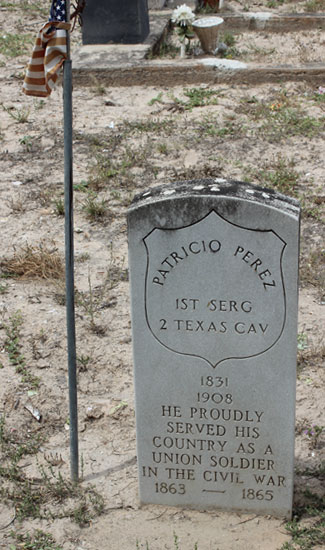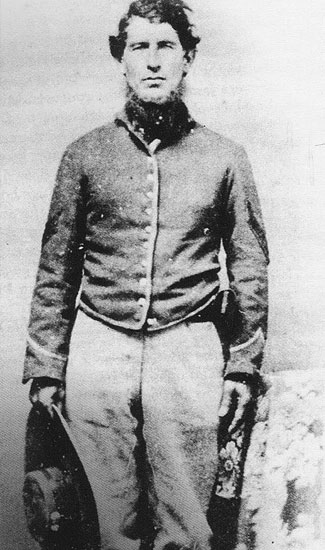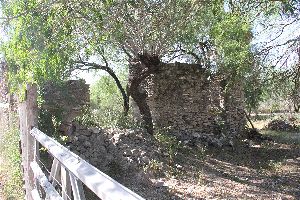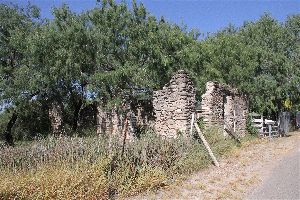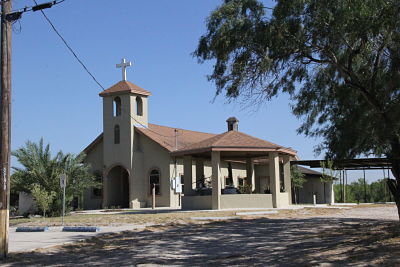Havana
One of many ranchos along the Military Highway, Havana was founded in 1767 and was named for the Spanish port city in Cuba. When the Civil War began, Havana found itself caught up in the sectional conflict. Generations of vaqueros and workers were born on the ranch and lived here. Among them was Patricio Pérez, who like most vaqueros was a skilled horseman. After Texas tried to leave the United States in 1861, many Tejanos used their skills with horses by joining the Confederate forces as cavalrymen. But Patricio Perez remained loyal to the Union. When federal troops occupied the Valley in late 1863, Pérez rode to Brownsville, where he enlisted with the Second Regiment of Texas Cavalry, one of many Tejanos to join Texas’ federal forces. He was issued the standard uniform, saber, and revolver, but a wartime photo shows him holding a big sombrero instead of regular army headgear. Pérez earned the rank of sergeant in 1864. The Second Regiment saw duty in the Brownsville area until it was ordered to New Orleans in July 1864. It remained in Louisiana and Mississippi until the war ended. Its soldiers, Sgt. Pérez among them, mustered out in November 1865. Patricio Pérez returned to Havana and to his life as a vaquero and rancher. He died in his seventies in 1908, and lies in the town’s cemetery, his wife Martina resting beside him.
Listen
Uno de los muchos ubicados a lo largo de la Carretera Militar, el Rancho Havana se fundó en 1767 con el nombre de la ciudad portuaria española de la isla de Cuba. Cuando irrumpió la Guerra de Secesión estadounidense, el rancho se vio atrapado en la contienda. Generaciones enteras de vaqueros y trabajadores habían nacido y vivido en el rancho, y entre ellos se encontraba Patricio Pérez, un avezado jinete al igual que la mayoría de vaqueros. Tras el intento secesionista de Texas en 1861, muchos tejanos utilizaron la destreza con sus monturas para unirse a los confederados como jinetes de la caballería, pero Patricio Pérez se mantuvo fiel a la Unión y, cuando las tropas federales ocuparon El Valle en 1863, Pérez cabalgó hasta Brownsville, donde se alistó en el Regimiento Segundo de la Caballería de Texas como uno de los numerosos que se afiliaron a la fuerzas federales. Se le entregó el uniforme regular, un sable y un revólver, pero una fotografía de la época del conflicto bélico le retrata con un amplio sombrero mexicano en vez del tocado militar reglamentario. Pérez alcanzó el rango de sargento en 1864 y el Segundo Regimiento sirvió en la zona de Brownsville hasta que fue movilizado a Nueva Orleans en julio de 1864, permaneciendo en La Luisiana y Mississippi hasta el final de la contienda. Los hombres del regimiento, con el sargento Pérez entre ellos, fueron desmovilizados en noviembre de 1865, con lo que regresó al Rancho Havana y a su vida como vaquero y ranchero. Murió en 1908, habiendo superado la los setenta años de edad, y su cuerpo descansa en el cementerio del lugar junto con el de su esposa Martina.
Escucha
Details
Location: Cemetery is located on the south side of U.S. 83, about 1.8 miles west of La Joya, in the community of Havana.
Access: Open to the public.

